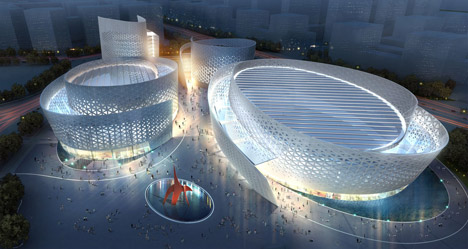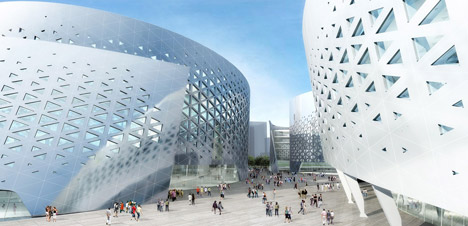Chengdu Tianfu Cultural and Performance Centre by Massimiliano and Doriana Fuksas
Italian architects Massimiliano and Doriana Fuksas have won a competition to build a cultural complex in Chengdu, China, with designs for spiralling buildings inspired by the city's ancient emblem.

The symbol, which depicts a sun with whirling rays, is reinterpreted by Studio Fuksas as four elliptical buildings with swirling, ribbon-like outer walls. These walls will be clad in metal and perforated with a grid of triangular windows.
"The elliptical shape of each building gives the impression of a perpetual motion and continuous vibration," explain the architects.

The two largest buildings will accommodate a performing arts centre and a cultural centre, with the former housing two theatres and a music hall, and the latter containing another theatre and an exhibition gallery. The remaining buildings will provide offices for a literary association and housing for resident artists, plus a series of gardens and public spaces will surround the buildings.
Construction is set to commence early next year.
This year Massimiliano and Doriana Fuksas also completed a school for hotel management in France and a public services hall in Georgia with a mushroom-like structure.
See more stories about Studio Fuksas »
See more stories about architecture in China »
Here's some more information from the architects:
Chengdu Tianfu Cultural and Performance Centre, Chengdu, China
Massimiliano and Doriana Fuksas have won the international competition for the construction of the first cultural center in the city of Chengdu. This city is the capital of Sichuan province and was hit by a terrible earthquake in 2008.
Studio Fuksas has other projects still going on in China and precisely in Shenzhen: the Guosen Tower and the Terminal 3 of the Bao'an International Airport that will be completed by next summer. Besides these projects Studio FUKSAS is preparing to realize this new one in the People’s Republic of China whose worth is 1 billion and 200 million yuan (150 million euro). The cultural complex consists of four buildings of elliptical shape with a spiral structure. The design concept is inspired by ancient symbol of the city of Chengdu (a circle with a sun with rays spiral) and demonstrates the willingness of the Chinese community to look at the future, focusing on art and culture. The project of Massimiliano and Doriana Fuksas was conceived as a symphony of architectural volumes, creating the effect of a music that you can listen to with your eyes. On a total area of about 110,000 square meters, the elliptical shape of each building gives the impression of a perpetual motion and continuous vibration. The surface of the facade is a continuous ribbon coated with a metal skin with openings geometric design that allow natural light to enter the interior of the four volumes. The complex is made up of a center for the performing arts that houses two theaters for a total of 1800 seats and a music hall (600 seats), a cultural center that includes a theater with 2600-3000 seats and an exhibition gallery, offices Writer and Literary Association, an apartment building for artists. All surrounded by green gardens that evoke the eastern hills of Sichuan, with their colorful vegetation. The construction should start early 2013, reflecting the dynamism and desire to grow of the big community of Chengdu, which is the fifth most populous city in China.
Project: Chengdu Tianfu Cultural and Performance Centre
Site: Chengdu, Sichuan, China
Period: Won competition 2012
Client: Sichuan Culture Centre, Literary and Writer
Architects: Massimiliano and Doriana Fuksas
Chinese partner: CSWADI
Area: 110,000 sq. m.
Program: Cultural Performance Center (theatre 1400 seats, music hall 600 seats, other theatre 400 seats); Public Cultural Center (theatre 2600/3000 seats, exhibition hall, mediateca); Literateur and Artist House e Research Institute (offices, archive, mediateca, atelier); residences for artists.
Cost: 1 billion and 200 million yuan (150 million euro).